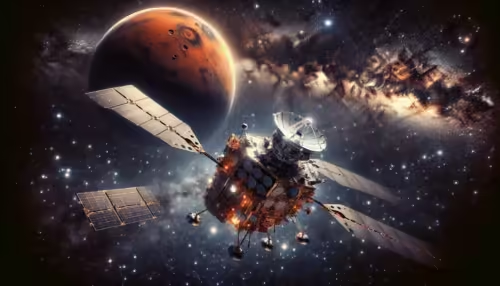Have you ever wondered what extraterrestrial frontiers the European Space Agency (ESA) has explored in recent years? The advent of advanced space exploration has ushered in an era of remarkable discoveries and innovations, and at the forefront of this exploration is the European Space Agency with its groundbreaking missions, Rosetta and Mars Express. These missions have not only expanded our understanding of the cosmos but have also forged significant scientific and technological breakthroughs. In this exploration of the ESA Blog Navigator data, you will gain insights into the unique facets of these missions, their historical context, current developments, and future implications.
Table of Contents
Understanding the Rosetta and Mars Express Missions
The Genesis of Rosetta and Mars Express
The Rosetta and Mars Express missions are quintessential examples of ESA’s drive to explore our solar system. Initiated in the early 21st century, these missions marked a new era in space exploration. The Rosetta mission, launched in 2004, sought to explore the comet 67P/Churyumov-Gerasimenko, providing unprecedented insights into the composition and behavior of comets. Mars Express, launched in 2003, targeted the investigation of the Martian atmosphere and surface.
Historical Context and Inception
These missions were born out of a long-standing tradition of curiosity and exploration at ESA. The conceptualization of Rosetta and Mars Express reflected a broader European ambition to contribute to the global understanding of space, moving beyond Earth-centric missions to uncover the mysteries of distant celestial bodies. With increasing collaboration in international space efforts and technological advancements, ESA equipped these missions with state-of-the-art instruments and scientific goals that were unprecedented at the time.
Recent Developments and Trends
Fast-forward to the present, the insights from these missions continue to influence and guide current and future space explorations. The data collected by Rosetta and Mars Express have significantly contributed to our understanding of cometary and Martian environments. This rich base of data has not only supported scientific research but has also set the stage for future missions with even more ambitious objectives.
Working synergistically with other space agencies, ESA has embraced open access to scientific data, encouraging the global scientific community to engage with the findings from these missions. Through harnessing collective expertise, ESA aims to remain at the forefront of space exploration.

Key Concepts and Definitions
What Makes Rosetta Revolutionary?
The Rosetta mission’s primary objective was to orbit and land on a comet, a feat that had never been attempted before. With this mission, ESA aimed to examine the primordial composition of a comet to gain insights into the early solar system. Utilizing a suite of scientific instruments, Rosetta provided crucial data on gravitational fields, surface composition, and outgassing mechanisms.
Deciphering Mars Express
Mars Express’s mission objectives were equally ambitious. As the first planetary mission attempted by ESA, it had goals ranging from mapping mineralogy on the Martian surface to detecting subsurface water and studying the planet’s atmosphere. Its payload included high-resolution cameras, spectrometers, and radar systems designed to gather comprehensive data about Mars.

Analyses and Case Studies
Rosetta’s Groundbreaking Discoveries
One of the most celebrated discoveries of Rosetta was its data on the composition of water vapor from the comet 67P, which differed markedly from that on Earth. This discovery challenged established theories about the origins of Earth’s water, suggesting that Earth’s water could have originated from asteroids, not comets as previously thought.
Further Implications
The analysis of organics and isotopic data gathered from Rosetta also hinted at the possible prebiotic ingredients necessary for life elsewhere in the cosmos. These findings fueled ongoing debates and research into the origins of life on Earth and the potential for life elsewhere.
Mars Express and Martian Mysteries
The Mars Express mission significantly contributed to the understanding of Mars’s geological history, confirming the presence of minerals that form in the presence of water. This was groundbreaking as it supported the hypothesis of Mars’s potentially habitable past.
Broader Applications
By revealing the seasonal changes in the Martian atmosphere, Mars Express has provided critical information about climatic patterns, advancing the possibilities for future manned missions to Mars. Such data are indispensable for understanding how a planet may evolve to support life or how it could be transformed to do so.
Comparative Perspectives on Space Missions
As you examine different approaches taken by space-faring organizations, ESA’s missions stand out due to their collaborative nature, cost-effectiveness, and significant reliance on international partnerships. For instance, while NASA’s Mars rovers emphasize surface mobility, Mars Express offered extensive orbital observations. This differentiation in mission design showcases a spectrum of strategies to explore Mars comprehensively.
| Mission | Key Focus | Distinguishing Feature |
|---|---|---|
| Rosetta | Cometary exploration | First to orbit and land on a comet |
| Mars Express | Martian geology | Comprehensive orbital mapping |
| NASA Curiosity | Surface exploration | Mobility with rover design |
| ISRO Mangalyaan | Mars surface imaging | Cost-effective mission design |
| CNSA Chang’e | Lunar exploration | Sampling and return capability |

Impacts and Future Direction
The Impacts of Rosetta and Mars Express
These missions have influenced subsequent space missions by demonstrating new technologies and methodologies for space research. Both Rosetta and Mars Express’s contributions are critical in framing the scientific questions that guide future explorations.
Predictions for Future Space Exploration
Building on the success of these missions, ESA has set its sights on deeper space exploration, targeting the moons of Jupiter and Saturn. Emphasis on understanding life’s potential beyond Earth continues to be a cornerstone of ESA’s scientific inquiry.
Looking Ahead
Expectations are high for the broadening of partnerships, technological advancements, and sustainable practices in future missions. The data-sharing ethos seen in Rosetta and Mars Express is expected to transcend future explorations, enabling a more connected and collaborative global scientific community.

Implications for Society and Industry
The advancements and findings from ESA missions have profound implications for technological progress in various fields such as telecommunications, remote sensing, and environmental monitoring. They also have societal impacts, inspiring educational pursuits in STEM fields and fostering international collaboration.
Conclusion
To conclude, ESA’s Rosetta and Mars Express missions have not only shaped our understanding of the cosmos but have also charted new courses for future explorations. The achievements of these missions reinforce the critical role of international and interdisciplinary collaboration in pushing the boundaries of knowledge. As we continue to find answers to age-old questions about space, what are your thoughts on the role of space exploration in shaping our future?
This exploration of ESA’s Rosetta and Mars Express missions highlights the organizational success rooted in scientific curiosity and determination. As you delve deeper into these topics, more questions will emerge, guiding humanity’s quest for understanding the universe. With these missions setting precedents for sustainable and collaborative exploration, the journey through space is one we are all a part of. What further frontiers do you think we should explore?


